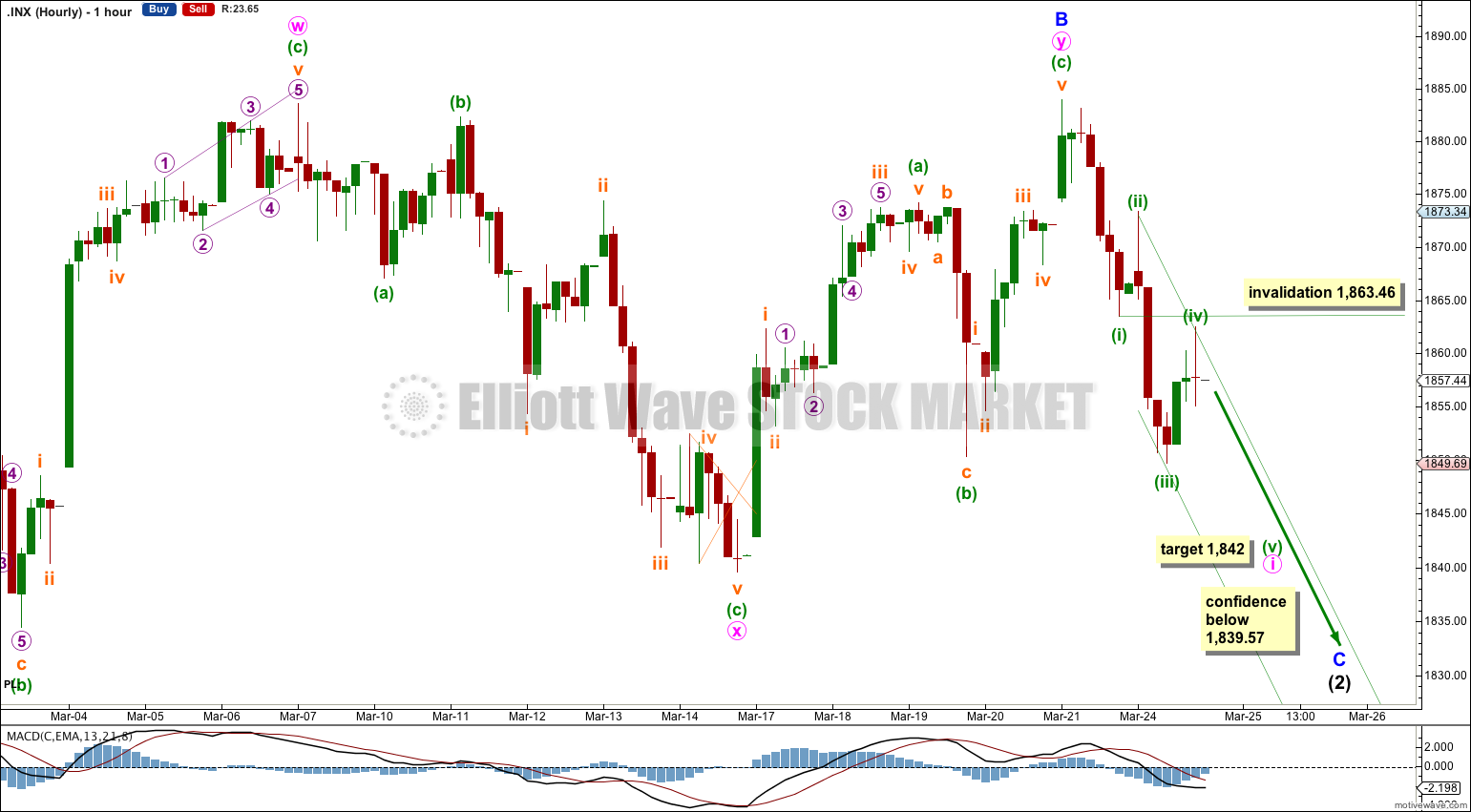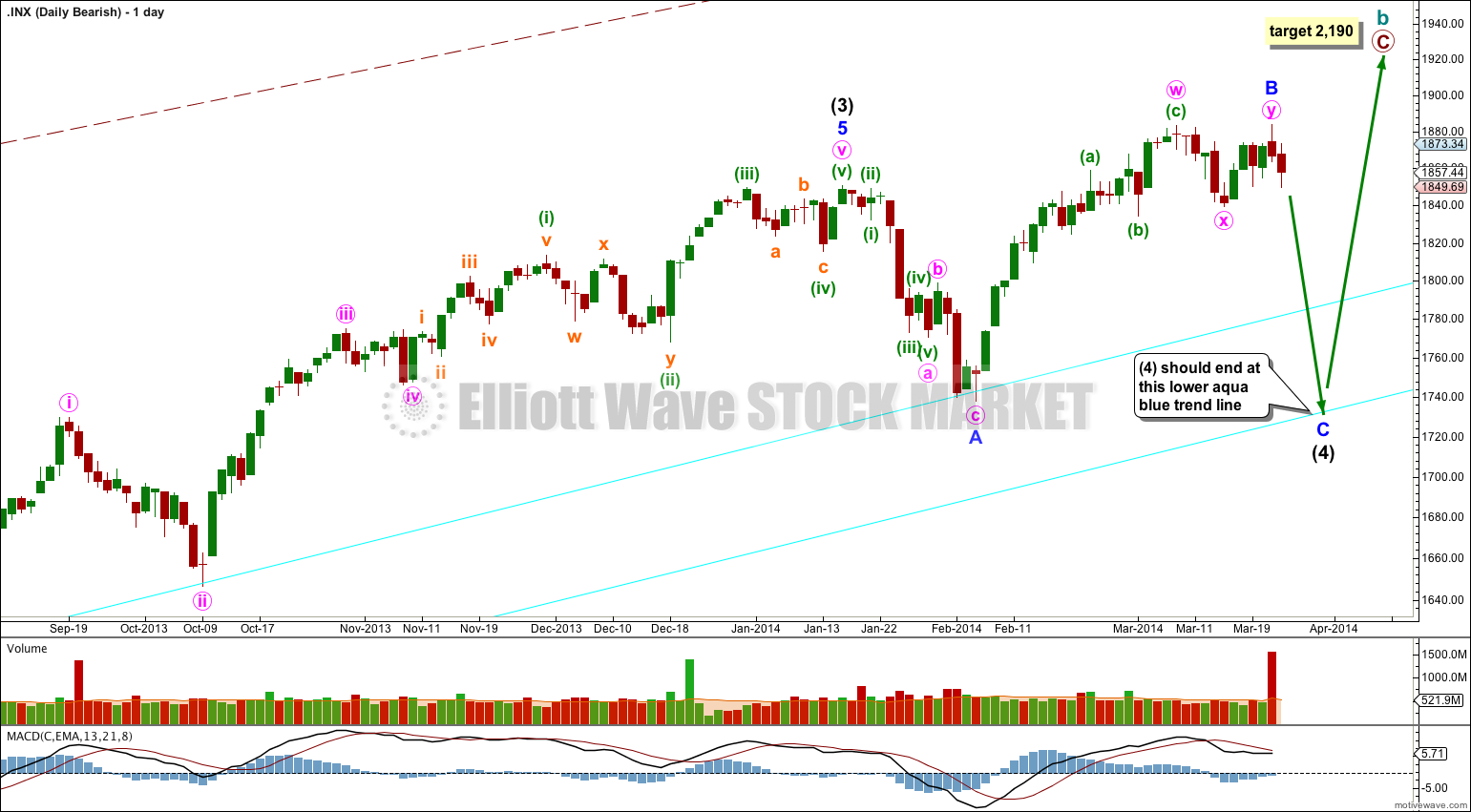Downwards movement was expected. Price has not moved low enough for confidence in this wave count yet. The outlook is unchanged.
Summary: I still expect a five wave structure downwards to end at the lower of the two aqua blue trend lines. The new high is unconfirmed by the DJIA, DJT, and Nasdaq. Recent upwards movement is very choppy and overlapping. Movement below 1,839.57 next week would provide confidence in this trend change at minor degree.
This analysis is published about 10:30 p.m. EST. Click on charts to enlarge.
Bullish Wave Count.
The aqua blue trend lines are critical for all wave counts. Draw the first trend line from the low of 1,158.66 on 25th November, 2011 to the next swing low at 1,266.74 on 4th June, 2012. Create a parallel copy and place it on the low at 1,560.33 on 24th June, 2013. While price remains above the lower of these two aqua blue trend lines we must assume the trend remains upwards. This is the main reason for the bullish wave count being my main wave count.
This bullish wave count expects a new bull market began at 666.79 for a cycle wave V. Within cycle wave V primary waves 1 and 2 are complete. Within primary wave 3 intermediate wave (1) is complete at 1,850.84. Intermediate wave (2) is continuing as an expanded flat correction.
Intermediate wave (2) should find strong support at the lower of the two aqua blue trend lines. Minor wave A lasted 14 days and minor wave B lasted 31 days. I would expect minor wave C to be of a similar duration and to last about three to four weeks in total.
For this bullish wave count when intermediate wave (2) is complete then very strong sustained upwards movement would be expected as an intermediate degree third wave within a primary degree third wave upwards unfolds.
Main Hourly Wave Count.
Minor wave C must subdivide as a five wave motive structure, either an impulse or an ending diagonal. An impulse is much more likely as it is more common.
Within minor wave C minute wave i may be an incomplete impulse. Minuette wave (iii) within it has no adequate Fibonacci ratio to minuette wave (i). At 1,842 minuette wave (v) would reach equality in length with minuette wave (i).
The channel is drawn using Elliott’s second technique: draw the first trend line from the ends of minuette waves (ii) to (iv), then place a parallel copy on the end of minuette wave (iii). Look for minuette wave (v) to find support and most likely end at the lower edge of this channel. When the channel is breached by subsequent upwards movement then minute wave i may be over and minute wave ii upwards should be underway.
If minuette wave (iv) moves any higher it may not move into minuette wave (i) price territory. This wave count is invalidated with movement above 1,863.46.
If this main hourly wave count is invalidated with upwards movement tomorrow then we may use the alternate below.
Alternate Hourly Wave Count.
By simply moving the degree of labeling within minuette wave (iii) down one degree it may be only subminuette waves i and ii which are almost complete.
At 1,840 minuette wave (iii) would reach 1.618 the length of minuette wave (i).
The channel drawn here is a base channel about minuette waves (i) and (ii). Upwards corrections should find resistance at the upper edge. Downwards movement for minuette wave (iii) should be strong enough to clearly breach the lower edge of this channel.
Subminuette wave ii may not move beyond the start of subminuette wave i. This wave count is invalidated with movement above 1,873.34.
Bearish Alternate Wave Count.
This bearish wave count expects that the correction was not over at 666.79, and that may have been just cycle wave a of a huge expanded flat for a super cycle wave II. Cycle wave b upwards is a close to complete zigzag.
Within flat corrections the maximum common length of B waves in relation to A waves is 138%. So far cycle wave b is a 141% correction of cycle wave a. For this reason only this wave count is an alternate.
Within primary wave C of the zigzag intermediate wave (4) would be incomplete.
The subdivisions for intermediate wave (4) would be the same as the main wave count for intermediate wave (2). I would expect it to end at the lower aqua blue trend line.
At 2,190 primary wave C would reach 1.618 the length of primary wave A. When intermediate wave (4) is complete I would recalculate this target at intermediate degree. I have found Fibonacci ratios between actionary waves (1, 3 and 5) of impulses are more reliable than between A and C waves within zigzags for the S&P500.
If intermediate wave (5) lasts about five to six months it may end about October this year.






“Movement below 1,839.57 next week would provide confidence in this trend change at minor degree.”
Lara, just wanting to clarify–do you see the probability of reaching 1839 next week or this week?
The main wave count expects it to be met this week. I still expect this has the most likely probability.